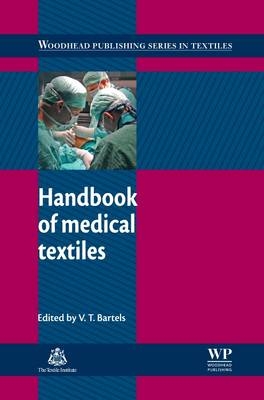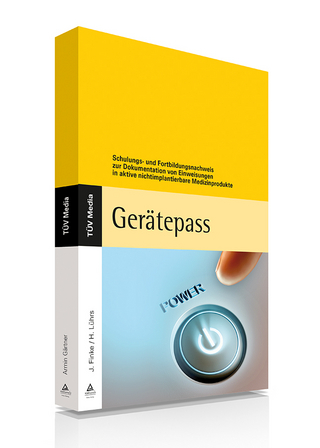
Handbook of Medical Textiles
Woodhead Publishing Ltd (Verlag)
978-1-84569-691-7 (ISBN)
With a rising population and the increasing range of textiles for medical products, the need to understand and improve medical textiles is gaining in importance. The Handbook of medical textiles provides an overview of the different types of medical textiles currently available as well as specific information on more specialised topics and applications.In part one, the types and properties of medical textiles are discussed, with chapters covering topics including reusable textiles, textiles for implants and textiles with cosmetic effects. Part two focuses on the interaction of textiles with the skin, examining key issues such as contact sensations, allergies and mechanical irritation. Chapters in part three provide information on the latest developments in textiles for hygiene and infection control, while part four provides a range of applications and case studies, including improvements in medical occupational clothing, medical filters and superabsorbent fibres.With its expert editor and contributions from some of the world’s leading authorities, the Handbook of medical textiles is a standard reference for designers and manufacturers of medical textile products, as well as for biomaterials scientists and medical professionals.
Dr Volkmar T. Bartels is the founder and managing director of Bartels Scientific Consulting GmbH.
Contributor contact details
Woodhead Publishing Series in Textiles
Preface
Part I: Types and properties of medical textiles
Chapter 1: Modern textiles and biomaterials for healthcare
Abstract:
1.1 Introduction
1.2 The role of textile structures and biomaterials in healthcare
1.3 Types of textiles and biomaterials for medical applications
1.4 Key properties of medical textile products
1.5 Contacting behaviour and transmission phenomenon of medical-based textiles
1.6 Engineering stability and compactness in medical textile systems
1.7 Advanced examples of research and product development
1.8 Future of medical textiles and products
1.9 Sources of further information and advice
1.10 Acknowledgement
Chapter 2: Hi-tech textiles for interactive wound therapies
Abstract:
2.1 Introduction
2.2 Wounds
2.3 Wound dressings
2.4 Venous leg ulcers and their treatment
2.5 Wound dressing structures
2.6 Conclusions
Chapter 3: Reusable medical textiles
Abstract:
3.1 Introduction
3.2 The role of reusable medical textiles: a historical perspective
3.3 Advantages of reusable textiles
3.4 Types of reusable textiles used for medical applications
3.5 Processing procedures
3.6 Healthcare costs
3.7 Future trends
3.8 Conclusions
Chapter 4: Nonwoven materials and technologies for medical applications
Abstract:
4.1 Introduction
4.2 Key issues of nonwovens
4.3 Main types of nonwovens and technologies for medical applications
4.4 Strengths and limitations of nonwoven materials (NMs) for medical applications
4.5 Applications of nonwovens in medicine
4.6 Future trends
4.7 Sources of further information and advice
Chapter 5: Textiles for implants and regenerative medicine
Abstract:
5.1 Introduction
5.2 Textiles as implants
5.3 Textiles for regenerative medicine
5.4 Testing of implants and materials for regenerative medicine
5.5 Sources for further information
Chapter 6: Textiles with cosmetic effects
Abstract:
6.1 Introduction
6.2 Application and release technologies
6.3 Functionalities of cosmetotextiles and performance testing
6.4 Safety evaluation and other regulatory aspects
6.5 Future trends
Chapter 7: Drug-releasing textiles
Abstract:
7.1 Introduction
7.2 Classification of drug-releasing textiles
7.3 Fabrication and characterization
7.4 Applications of drug-releasing textiles
7.5 Conclusions
7.6 Future trends
7.7 Acknowledgments
Chapter 8: Medical textiles and thermal comfort
Abstract:
8.1 Fundamentals of thermal comfort
8.2 Healthcare workers and patients in the hospital environment
8.3 Thermal comfort of medical textiles: surgical gowns
8.4 Evaluation and testing of thermal properties for medical textiles
8.5 Future trends
Part II: Textiles and the skin
Chapter 9: Contact sensations of medical textiles on the skin
Abstract:
9.1 Introduction
9.2 Skin contact sensations
9.3 Textile properties influencing skin contact sensations
9.4 Examples of applications
9.5 Future trends
9.6 Conclusions
9.7 Sources of further information
9.8 Acknowledgment
Chapter 10: Mechanical skin irritations due to textiles
Abstract:
10.1 Introduction
10.2 Human skin
10.3 Skin irritation
10.4 Skin responses to mechanical forces
10.5 Measurement of irritating mechanical factors
10.6 Factors causing a textile to be mechanically irritating
Chapter 11: Allergies caused by textiles
Abstract:
11.1 Introduction
11.2 Types of allergies
11.3 Main types of allergies caused by textiles
11.4 Ways to minimise and avoid allergies caused by textiles
11.5 Testing for allergy-causing substances
11.6 Medical textile applications
11.7 Sources of further information and advice
Chapter 12: Biofunctional textiles based on cellulose and their approaches for therapy and prevention of atopic eczema
Abstract:
12.1 Introduction
12.2 The role of microbial infections in atopic dermatitis
12.3 Skin barrier function and increased sensitivity to irritants
12.4 Lyocell fibres for antimicrobial therapy
12.5 SeaCell® textiles for antimicrobial therapy
12.6 Future trends and conclusions
Part III: Textiles for hygiene
Chapter 13: Infection prevention and control and the role of medical textiles
Abstract:
13.1 Introduction
13.2 Superbugs and healthcare-associated infections (HAIs)
13.3 Principles and practice of infection prevention and control in hospitals
13.4 The role of textiles in infection prevention and control
13.5 Future challenges
13.6 A holistic approach to preventing infections
Chapter 14: Absorbent products for personal health care and hygiene
Abstract:
14.1 Introduction
14.2 Different types of absorbent products for personal health and hygiene
14.3 Key issues of absorbent hygiene products
14.4 Testing of absorbent hygiene products
14.5 Application example: diapers – adapting products from premature babies to toilet training
14.6 Future trends
14.7 Sources of further information and advice
14.8 Acknowledgements
Chapter 15: Bio-functional textiles
Abstract:
15.1 Introduction
15.2 Types of bio-functional textiles
15.3 Evaluation of bio-functional effects and safety
15.4 Applications of bio-functional textiles
15.5 Manufacturing of bio-functional textiles
15.6 Future trends
Chapter 16: Hospital laundries and their role in medical textiles
Abstract:
16.1 Introduction
16.2 Key issues of hospital laundries
16.3 Impact of hospital laundries on the hygiene of medical textiles
16.4 Testing and quality control of hygienic properties in hospital laundries
16.5 State of the art in hospital laundries
16.6 Future trends
16.9 Appendix: additional information
Chapter 17: Odour control of medical textiles
Abstract:
17.1 Introduction
17.2 Measurement of odour
17.3 Key issues of odour control in medical applications
17.4 Control of odour with textiles
17.5 Future trends
17.6 Acknowledgement
Part IV: Medical textile case studies and applications
Chapter 18: Textiles for medical filters
Abstract:
18.1 Introduction
18.2 Key issues of medical filters
18.3 Application of hollow fiber bioreactors
18.4 Evaluation and characterization of medical filters
18.5 Future trends
Chapter 19: Textiles for patient heat preservation during operations
Abstract:
19.1 Key issues and importance of preventing cold stress in patients during operations
19.2 Main types of textiles used to maintain patient temperature during operations
19.3 Applications of textiles in maintaining patient temperature
19.4 Future trends
Chapter 20: Evaluation of occupational clothing for surgeons: achieving comfort and avoiding physiological stress through suitable gowns
Abstract:
20.1 Historical background
20.2 Surgical gowns
20.3 Influences on wear properties
20.4 Elements of comfort
20.5 Evaluation of parameters relevant for comfortable textiles
20.6 Sweating as an effect of physiological stress
20.7 Controlled wear tests
20.8 Purchasing criteria
20.9 Conclusions and recommendations
Chapter 21: Occupational clothing for nurses: combining improved comfort with economic efficiency
Abstract:
21.1 Introduction
21.2 Materials and methods
21.3 Cleanliness
21.4 Improving comfort in nurses′ occupational clothing
21.5 Improving durability of nurses’ clothing in industrial laundering processes
21.6 Possible savings in resources, washing and drying, durability and nosocomial infections
21.7 Applications of knitted microfibre fabrics
21.8 Future trends
21.9 Sources of further information and advice
21.10 Acknowledgement
Chapter 22: Medical bandages and stockings with enhanced patient acceptance
Abstract:
22.1 Introduction
22.2 Key issues and role of medical bandages and stockings
22.3 Improving patient acceptance of medical bandages and stockings
22.4 Conclusions
Chapter 23: Superabsorbents and their medical applications
Abstract:
23.1 Introduction
23.2 Methods of obtaining superabsorbent polymers and their chemical structure
23.3 Forms of superabsorbents and their properties
23.4 Development stages of superabsorbent materials according to appropriate patents
23.5 Applications of superabsorbents in medicine
23.6 Applications of superabsorbents in hygiene products and medical textiles
23.7 Applications of superabsorbents for comfort improvement
23.8 Ergonomie tests
23.9 Application of superabsorbent materials in half masks
23.10 Conclusions
Chapter 24: Nanofibrous textiles in medical applications
Abstract:
24.1 Introduction
24.2 Nanofibrous textiles
24.3 Applications of nanofibres in the medical field
24.4 Future trends
24.5 Sources of further information and advice
Index
| Reihe/Serie | Woodhead Publishing Series in Textiles |
|---|---|
| Verlagsort | Cambridge |
| Sprache | englisch |
| Maße | 156 x 234 mm |
| Gewicht | 1030 g |
| Themenwelt | Medizin / Pharmazie |
| Technik ► Medizintechnik | |
| ISBN-10 | 1-84569-691-3 / 1845696913 |
| ISBN-13 | 978-1-84569-691-7 / 9781845696917 |
| Zustand | Neuware |
| Haben Sie eine Frage zum Produkt? |
aus dem Bereich
